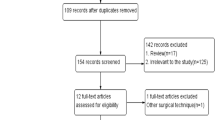Abstract
Although the mesh plug procedure is an effective operation, sutureless implantation of a single onlay mesh, if successful, would avoid the risks of plug-related complications. One hundred patients with primary inguinal hernias were randomized to undergo PerFix Plug or Hertra 1 implantation. Mean duration of the operation was similar, 38 versus 35 min for plug and onlay mesh implantation, respectively (nonsignificant, NS). The level of postoperative pain and early complication rate was similarly low in both groups (NS). Recurrence rate was the same—2 patients in each group (4%)—all following large hernia repair. The level of long-term discomfort was low after each type of operation (NS). Implantation of the onlay mesh—Hertra 1 as compared to the use of PerFix Plug is simple, safe, and equally effective in small and medium inguinal hernia repair, suggesting that a plug device is not necessary for successful hernia surgery.

Similar content being viewed by others
References
EU Hernia Trialists Collaboration (2002) Open mesh versus non-mesh repair of groin hernia meta-analysis of randomized trials. Hernia 6:130–136
Stephenson BM (2003) Complication of open groin hernia repairs. Surg Clin N Am 83:1255–1278
Nilsson E, Kald A, Anderberg B, Bragmark M, Fordell R, Haapaniemi S, Heuman R, Lindhagen J, Stubberod A, Wickbom J (1997) Hernia surgery in a defined population: a prospective three-year audit. Eur J Surg 163:823–829
Millikan KW, Cummings B, Doolas A. (2003) The Millican modified mesh-plug hernioplasty. Arch Surg 138:525–530
Rutkow IM (2003) The PerFix plug repair groin hernia. Surg Clin N Am 83:1079–1098
Chuback JA, Singh RS, Sills C, Dick LS (2000) Small bowel obstruction resulting from mesh plug migration after open inguinal hernia repair. Surgery 127:475–476
Dieter RA Jr (1999) Mesh plug migration in scrotum. Int Surg 84:57–59
Pelissier EP, Blum D, Damas JM, Marre P. (1999) The plug method in inguinal hernia: a prospective evaluation. Hernia 4:201–204
Palot JP, Avisse C, Calliez-Tomasi JP, Greffier D FlamentJB (1998) The mesh plug repair of groin hernias: a three year experience. Hernia 2:31–34
Amid PK, Lichteinstein IL. (1998) Long-term result and current status of Lichteinstein open tension-free hernioplasty. Hernia 2:89–94
Amid PK (1999) Classification of biomaterials and their related complication in abdominal wall hernia surgery. Hernia 1:15–21
Le Blanc KA (2001) Complication associated with the plug-and-patch method of inguinal herniorhaphy. Hernia 5:15–21
Trabucco EE, Trabucco AF (2002) Tension-free sutureless preshaped mesh hernioplasty. In: Fitzgibbons RJ, Greenburg AG (eds) Nyhus and Condons hernia. Lippincott Williams & Wilkins, Philadelphia, pp 159–164
Trabucco EE, Trabucco AF. (1998) Flat plug and mesh hernioplasty in the “inguinal box”: description of the surgical technique. Hernia 2:133–138
Zollinger Jr RM (2003) Classification system for groin hernias. Surg Clin N Am 83:1053–1063
Millikan KW, Cummings B, Doolas A. (2001) A prospective study of the Mesh-plug Hernioplasty. Am Surg 67:285–289
Callesen T, Bech K, Nielsen R, Andersen J, Hesselfeldt P, Roikjaer O, Kehlet H. (1998) Pain after groin hernia repair. Br J Surg 85:1412–1414
Cunningham J, Temple WJ, Mitchell P, Nixon JA, Preshaw RM, Hagen NA (1996) Cooperative hernia study. Pain in the postrepair patient. Ann Surg 224:598–602
Mann DV, Prout J, Havranek E, Gould S, Darzi A. (1998) Late- onset deep prosthetic infection following mesh repair of inguinal hernia. Am J Surg 176:12–14
Witkowski P, Pirski MI, Adamonis W, Śmietański M, Drączkowski T, Śledziński Z (2000) Mesh plug versus Bassini operation. Randomized prospective study. Hernia 4:305–310
Kux M., Fuchsjager N, Schemper M (1994) Shouldice is superior to Bassini inguinal herniorrhaphy. Am J Surg 168:15–18
Millican KW, Diezel DJ. (1996) The management of hernia. Considerations in cost effectiveness. Surg Clin N Am 76:105–115
Schrenk P, Woisetschlager R, Rieger R, Wayand W (1996) Prospective randomized trial comparing postoperative pain and return to physical activity after transabdominal preperitoneal, total preperitoneal or Shouldice technique for inguinal hernia repair. Br J Surg 83:1563–1566
Rutkow IM. (2003) Demographic and socioeconomic aspects of hernia repair in the United States in 2003. Surg Clin N Am 83:1045–1051
Trabucco E, Campanelli P, Cavagnoli R. (1998) New polypropylene hernia prosthesis. Minerva Chir 53(4):337–341
Testini M, Miniello S, Piccinni G, Di Venere B, Lissidini G, Greco L, Bonomo GM (2002) Trabucco versus Rutkow versus Lichtenstein techniques in the treatment of groin hernia. A controlled randomized clinical trial. Minerva Chir 57:371–376
Shin D, Lipshultz LI, Goldstein M, Barme GA, Fuchs EF, Nagler HM, McCallum SW, Niederberger CS, Schoor RA, Brugh VM 3rd, Honig SC (2005) Herniorrhaphy with polypropylene mesh causing inguinal vasal obstruction: a preventable cause of obstructive azoospermia. Ann Surg 241(4):553–559
Acknowledgment
We would like to express our appreciation to Professor Mark A. Hardy, M.D., Ermanno E. Trabucco, M.D. and Eric Liu, M.D. for their review of the manuscript and suggestions.
Author information
Authors and Affiliations
Corresponding author
Rights and permissions
About this article
Cite this article
Adamonis, W., Witkowski, P., Śmietański, M. et al. Is there a need for a mesh plug in inguinal hernia repair? Randomized, prospective study of the use of Hertra 1 mesh compared to PerFix Plug. Hernia 10, 223–228 (2006). https://doi.org/10.1007/s10029-006-0067-5
Received:
Accepted:
Published:
Issue Date:
DOI: https://doi.org/10.1007/s10029-006-0067-5





